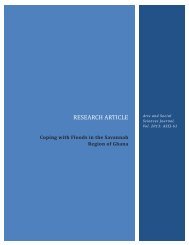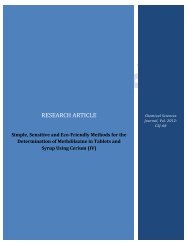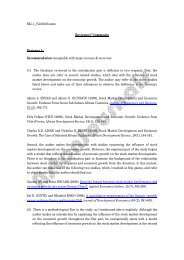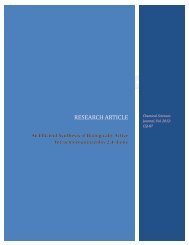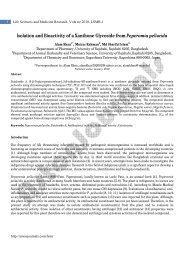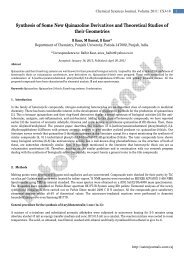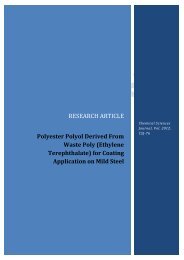Simple and Rapid Spectrophotometric ... - AstonJournals
Simple and Rapid Spectrophotometric ... - AstonJournals
Simple and Rapid Spectrophotometric ... - AstonJournals
Create successful ePaper yourself
Turn your PDF publications into a flip-book with our unique Google optimized e-Paper software.
Chemical Sciences Journal, Vol. 2012: CSJ-71<br />
1<br />
<strong>Simple</strong> <strong>and</strong> <strong>Rapid</strong> <strong>Spectrophotometric</strong> Determination of Propranolol<br />
Hydrochloride as Base Form in Pharmaceutical Formulation through<br />
Charge Transfer Complexation<br />
KN Prashanth, K Basavaiah*<br />
Department of Chemistry, University of Mysore, Manasagangotri, Mysore, India.<br />
*Correspondence to: Kanakapura Basavaiah, basavaiahk@yahoo.co.in<br />
Accepted: Sep 14, 2012; Published: Sep 30, 2012<br />
Abstract<br />
Two simple <strong>and</strong> selective spectrophotometric methods are described for the determination of propranolol hydrochloride (PPH)<br />
as base form (PPL) in bulk drug, <strong>and</strong> in tablets <strong>and</strong> capsules. The methods are based on the molecular charge-transfer<br />
complexation of propranolol base (PPL) with either 2,4,6-trinitrophenol (picric acid; PA) or 2,4-dinitrophenol (DNP). The yellow<br />
colored radical anions formed on dissociation, are quantitated at 425 nm (PA method) or 415 nm (DNP method). The assay<br />
conditions were optimized. Beer's law is obeyed in the concentration ranges 2.4-42.0 µg ml -1 in PA method <strong>and</strong> 9.0-126.0 µg ml -<br />
1 in DNP method, with respective molar absorptivity values of 4.97 × 10 3 <strong>and</strong> 1.66 × 10 3 l mol -1 cm -1 . The reaction stoichiometry<br />
in both methods was evaluated by Job’s method of continuous variations <strong>and</strong> was found to be 1:1 (PPL:PA, PPL:DNP). The<br />
developed methods were successfully applied to the determination of PPL in pure form <strong>and</strong> commercial tablets/capsules with<br />
good accuracy <strong>and</strong> precision. Statistical comparison of the results was performed using Student's t-test <strong>and</strong> F-ratio at 95%<br />
confidence level <strong>and</strong> the results showed no significant difference between the reference <strong>and</strong> proposed methods with regard to<br />
accuracy <strong>and</strong> precision. Further, the accuracy <strong>and</strong> reliability of the methods were confirmed by recovery studies via st<strong>and</strong>ard<br />
addition technique.<br />
Keywords: Propranolol hydrochloride; spectrophotometric assay; charge transfer complexes; pharmaceuticals.<br />
1. Introduction<br />
Propranolol hydrochloride (PPH), a non-selective beta-adrenoceptor antagonist, chemically known as (2RS)-1-[(1-<br />
Methylethyl)amino]-3-(naphthalen-1-yloxy)propan-2-ol hydrochloride (Figure 1) [1]. PPH is commonly used in the<br />
management of hypertension, angina pectoris, cardiac dysrhythmias, hypertrophic obstructive cardiomyopathy,<br />
myocardial infarction, anxiety, essential tremor <strong>and</strong> migraine. This beta-blocker may work by stabilizing arteries or<br />
preventing the central generator of migraine in the brainstem from firing. Of the many beta-blockers, PPH is the<br />
most effective for prevention of migraine. The drug is official in British Pharmacopoeia [2] <strong>and</strong> United States<br />
Pharmacopoeia [3], which describe UV-spectrophotometric methods for the assay of PPH after extraction into<br />
methanol, <strong>and</strong> also in Indian Pharmacopoeia [4] which describes a potentiometric titration of drug in ethanol with<br />
0.1 M NaOH.<br />
O<br />
OH<br />
N<br />
H2<br />
.Cl<br />
Figure 1: Structure of propranolol hydrochloride.<br />
Due to its therapeutic <strong>and</strong> pharmacological relevance, several methods have been reported for PPH <strong>and</strong><br />
include high-performance liquid chromatography (HPLC) [4], thin layer chromatography [5], UVspectrophotometry<br />
[6-9], fluorimetry [10], voltammetry [11] <strong>and</strong> chemiluminometry [12, 13]. These techniques<br />
involve an expensive experimental set up <strong>and</strong> are not always easily accessible. Few titrimetric [14, 15] <strong>and</strong> visible<br />
spectrophotometric [16-32] methods have also been reported.<br />
http://astonjournals.com/csj



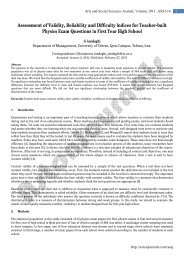
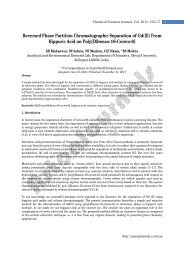
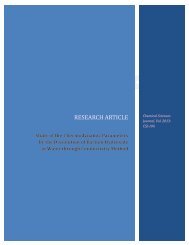
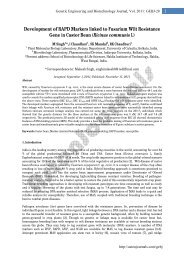

![[1,4]-benzodiazepine-2-one Derivatives as Potent - AstonJournals](https://img.yumpu.com/49117784/1/184x260/14-benzodiazepine-2-one-derivatives-as-potent-astonjournals.jpg?quality=85)
